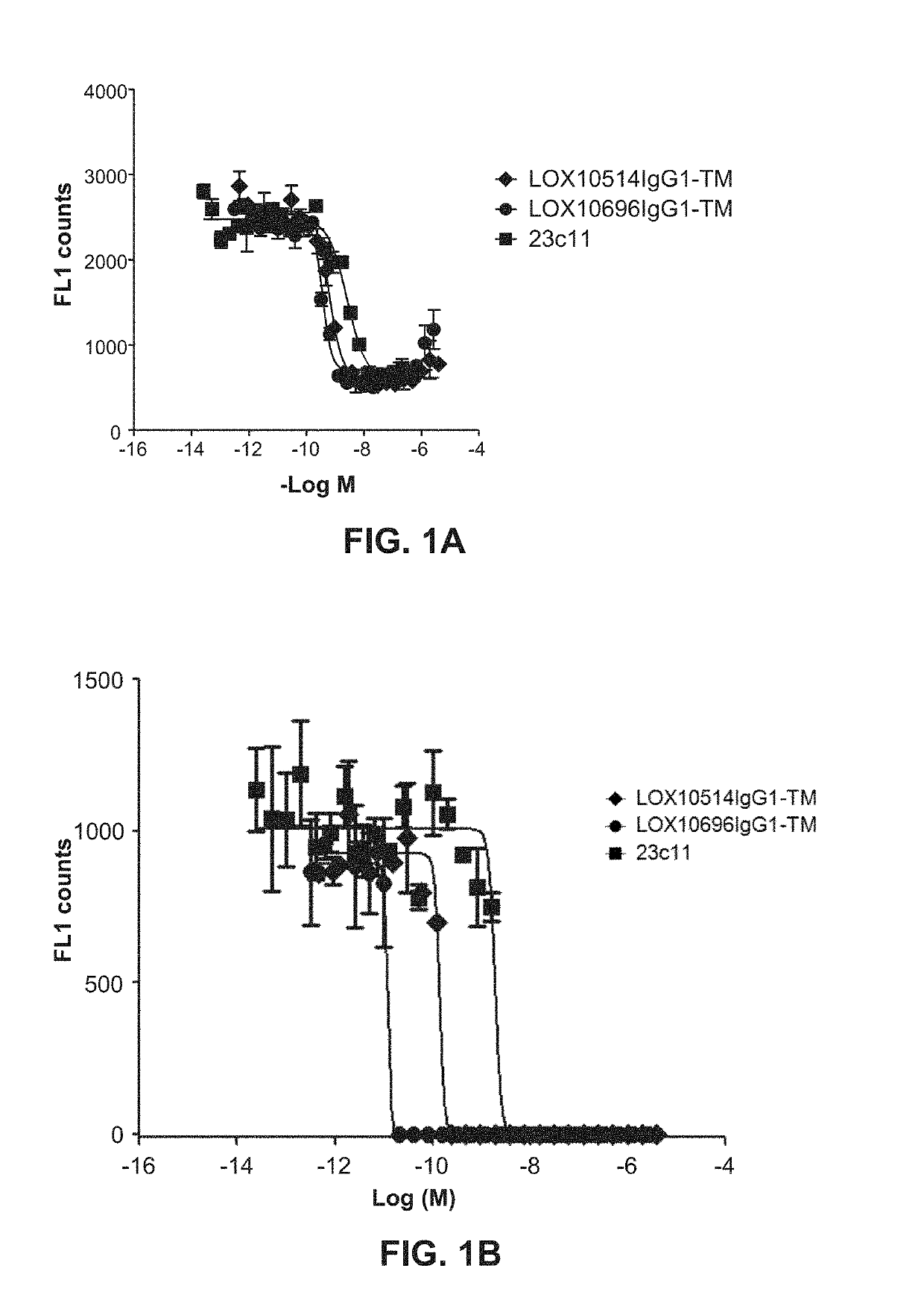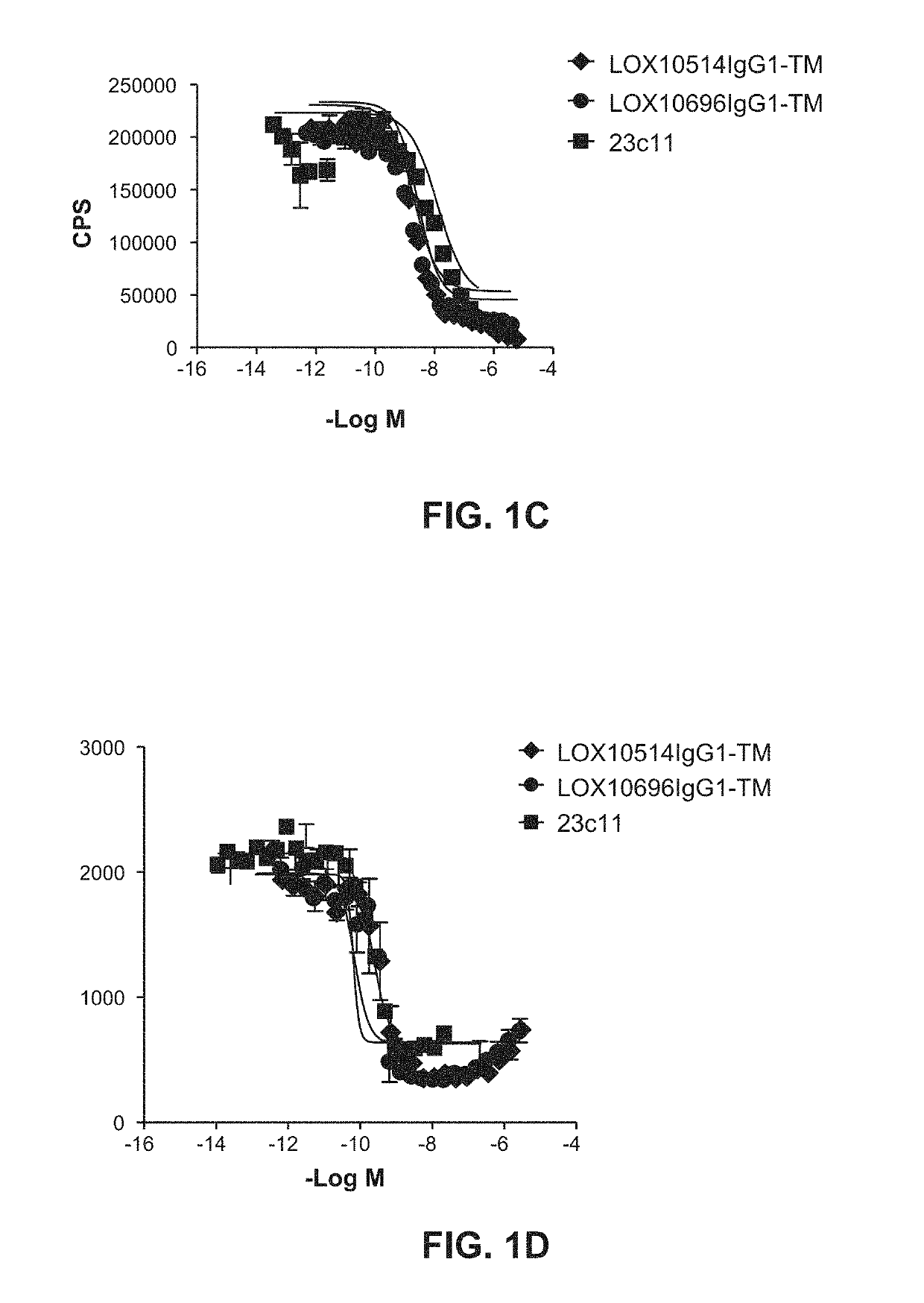Binding proteins specific for lox1 and uses thereof
a technology of binding proteins and lox1, which is applied in the field of binding proteins specific for lox1, can solve the problems of adverse cardiovascular events, large number of patients suffering secondary major adverse cardiovascular events, etc., and achieve the effects of reducing signaling, reducing apoptosis in plaques, and reducing caspase 8
- Summary
- Abstract
- Description
- Claims
- Application Information
AI Technical Summary
Benefits of technology
Problems solved by technology
Method used
Image
Examples
example 1
and Identification of Anti-LOX1 scFv Antibodies
[0329]A large single chain Fv (scFv) human antibody library derived from bone marrow from adult naïve donors and cloned into a phagemid vector based on filamentous phage M13 was used for selections (Hutchings, C., Generation of Näive Human Antibody Libraries, in Antibody Engineering, R. Kontermann and S. Dubel, Editors. 2001, Springer Laboratory Manuals, Berlin. p. 93). LOX1-specific scFv antibodies were isolated from the phage display library in a series of repeated selection cycles on recombinant mammalian expressed human LOX1 (R&D Systems) essentially as previously described (Vaughan et al., Nat. Biotechnol. 14:309 (1996)). While several antigen-specific scFvs were obtained from different variations of this protocol, the parental clones LOX514 (SEQ ID NO:29 (VH) and SEQ ID NO:33 (VL); also referred herein as “LOX10514”) and LOX696 (SEQ ID NO:54 (VH) and SEQ ID NO:70 (VL); also referred herein as “LOX10696”) were isolated as follows: ...
example 2
Antibodies Inhibit Multi-Ligand Binding, oxLDL Internalization and oxLDL Induced Signaling
[0332]Purified IgGs were tested for their ability to specifically inhibit oxidized low-density lipoprotein (“oxLDL”), advanced glycation end product of bovine serum albumin (“AGE-BSA”) and C-reactive protein (“CRP”) binding to LOX1 as described in Example 10, Assays 1, 2 and 3. A number of isolated clones including LOX10514 and LOX10696, and commercially available mouse anti-LOX1 antibody (23C11) were tested for their ability to block oxLDL, AGE-BSA and CRP binding to LOX1 I. Representative plots are shown in FIGS. 1A, IB and IC showing inhibition of oxLDL, AGE-BSA and CRP binding, respectively, by LOX514 and LOX696. To confirm the antibodies cross react and had functional activity on the LOX1 SNP K167N the antibodies were tested for their ability to block oxLDL binding to LOX1 SNP K167N. LOX1 SNP K167N (GenBank Accession No. AB102861) is a naturally occurring human LOX1 variant originally disc...
example 3
Antibodies Species Cross-Reactivity and Specificity for Human LOX1 Over a Panel of Human Related Family Members
[0334]Cross-reactivity of anti-human LOX1 antibodies to various LOX1 species orthologs was assessed by a scFv binding ELISA. Extracellular domain constructs for human (Uniprot: P78380), mouse (Uniprot: Q9EQ09), rat (Uniprot: 070156), rabbit (Uniprot: Q9XTA8) and cynomolgus monkey LOX1 were designed with either N or C terminal Flag and histidine tags and cloned into Gateway destination vectors (Invitrogen). The constructs were then transfected into mammalian HEK293 EBNA cells for protein expression. The proteins then underwent standard affinity and size exclusion chromatography purification. Briefly, human (HisFlag)-LOX1, cynomolgus LOX1-(FlagHis), mouse LOX1-(FlagHis), rat LOX1-(FlagHis) and rabbit LOX1-(FlagHis) were coated at 10, 10, 5, 5 and 5 μg / mL in PBS buffer respectively on MAXISORP™ plates. Efficient antigen coating using such concentrations was first checked by EL...
PUM
 Login to View More
Login to View More Abstract
Description
Claims
Application Information
 Login to View More
Login to View More - R&D
- Intellectual Property
- Life Sciences
- Materials
- Tech Scout
- Unparalleled Data Quality
- Higher Quality Content
- 60% Fewer Hallucinations
Browse by: Latest US Patents, China's latest patents, Technical Efficacy Thesaurus, Application Domain, Technology Topic, Popular Technical Reports.
© 2025 PatSnap. All rights reserved.Legal|Privacy policy|Modern Slavery Act Transparency Statement|Sitemap|About US| Contact US: help@patsnap.com



